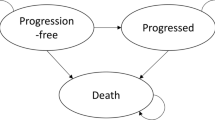Abstract
As options for systemic therapy for cancer continue to expand and median survival for many solid tumors lengthens, the divisions between active oncologic and palliative care continue to blur. Despite the well-recognized need to integrate palliative support for those with metastatic cancer, data on best practices facilitating the transition from active oncologic to active palliative care are lacking. Recent evidence outlining evolving issues surrounding this transition in care is reviewed, emphasizing the need for rigorous research efforts to define best practices and interventions.
Similar content being viewed by others
References and Recommended Reading
Cummings LC, Payes JD, Cooper GS: Survival after hepatic resection in metastatic colorectal cancer: a population-based study. Cancer 2007, 109:718–726.
Escudier B, Eisen T, Stadler WM, et al.: Sorafenib in advanced clear-cell renal-cell carcinoma. N Engl J Med 2007, 356:125–134.
Motzer RJ, Hutson TE, Tomczak P, et al.: Sunitinib versus interferon alfa in metastatic renal-cell carcinoma. N Engl J Med 2007, 356:115–124.
Burris HA, Moore MJ, Anderson J, et al.: Improvements in survival and clinical benefit with gemcitabine as first-line therapy for patients with advanced pancreas cancer: a randomized trial. J Clin Oncol 1997, 15:2403–2413.
Earle CC, Neville BA, Landrum MB, et al.: Trends in the aggressiveness of cancer care near the end of life. J Clin Oncol 2004, 22:315–321.
Murillo JR Jr, Koeller J: Chem otherapy given near the end of life by community oncologists for advanced non-small cell lung cancer. Oncologist 2006, 11:1095–1099.
Earle CC, Park ER, Lai B, et al.: Identifying potential indicators of the quality of end-of-life cancer care from administrative data. J Clin Oncol 2003, 21:1133–1138.
Barbera L, Paszat L, Chartier C: Indicators of poor quality end-of-life cancer care in Ontario. J Palliat Care 2006, 22:12–17.
Higginson IJ, Astin P, Dolan S: Where do cancer patients die? Ten-year trends in the place of death of cancer patients in England. Palliat Med 1998, 12:353–363.
Hunt R, Bonett A, Roder D: Trends in the terminal care of cancer patients: South Australia, 1981–1990. Aust N Z J Med 1993, 23:245–251.
Neutel CI, Bishop ML, Harper SD, et al.: Proportion of cancer deaths occurring in hospital, Canada, 1994–2000. Can J Public Health 2005, 96:264–268.
Burge F, Lawson B, Johnston G: Where a cancer patient dies: the effect of rural residency. J Rural Health 2005, 21:233–238.
Burge FI, Lawson B, Johnston G, et al.: Health care restructuring and family physician care for those who died of cancer. BMC Fam Pract 2005, 6:1.
Burge FI, Lawson B, Critchley P, et al.: Transitions in care during the end of life: changes experienced following enrolment in a comprehensive palliative care program. BMC Palliat Care 2005, 4:3.
Grunfeld E, Lethbridge L, Dewar R, et al.: Towards using administrative databases to measure population-based indicators of quality end-of-life care: testing the methodology. Palliat Med 2006, 20:769–777.
Burge F, Lawson B, Johnston G: Family physician continuity of care and emergency department use in end-of-life cancer care. Med Care 2003, 41:992–1001.
Trask PC, Teno JM, Nash J: Transitions of care and changes in distressing pain. J Pain Symptom Manage 2006, 32:104–109.
Schofield P, Carey M, Love A, et al.: ’Would you like to talk about your future treatment options?’ discussing the transition from curative cancer treatment to palliative care. Palliat Med 2006, 20:397–406.
Slevin ML, Stubbs L, Plant HJ, et al.: Attitudes to chemotherapy: comparing views of patients with cancer with those of doctors, nurses, and general public. BMJ 1990, 300:1458–1460.
Matsuyama R, Reddy S, Smith TJ: Why do patients choose chemotherapy near the end of life? A review of the perspective of those facing death from cancer. J Clin Oncol 2006, 24:3490–3496.
Burns CM, Broom DH, Smith WT, et al.: Fluctuating awareness of treatment goals among patients and their caregivers: a longitudinal study of a dynamic process. Support Care Cancer 2007, 15:187–196
Cherlin E, Fried T, Prigerson HG, et al.: Communication between physicians and family caregivers about care at the end of life: when do discussions occur and what is said? J Palliat Med 2005, 8:1176–1185.
Lawson B, Burge FI, Critchley P, et al.: Factors associated with multiple transitions in care during the end of life following enrollment in a comprehensive pallisive care program. BMC Palliat Care 2006, 5:4.
Levy MH, Back A, Bazargan S, et al.: Palliativecare. Clinical practice guidelines in oncology. J Natl Compr Canc Netw 2006, 4:776–818.
National Institute for Clinical Excellence: Improving supportive and palliative care for adults with cancer. Available at http://www.nice.org.uk. Accessed January 29, 2006.
Canadian Strategy for Cancer Control: Palliative Care Working Group Report 2002. http://www.cancercontrol.org . Accessed April 25, 2007.
ASCO-ESMO consensus statement on quality cancer care. J Clin Oncol 2006, 24:3498–3499.
Bomba PA, Vermilyea D: Integrating POLST into palliative care guidelines: a paradigm shift in advance careplanning in oncology. J Natl Compr Canc Netw 2006, 4:819–829.
Coleman EA, Parry C, Chalmers S, et al.: Thecare transitions intervention: results of a randomized controlled trial. Arch Intern Med 2006, 166:1822–1828.
Author information
Authors and Affiliations
Corresponding author
Rights and permissions
About this article
Cite this article
Rayson, D., McIntyre, P. Transitions to palliation: Two solitudes or inevitable integration?. Curr Oncol Rep 9, 285–289 (2007). https://doi.org/10.1007/s11912-007-0035-y
Published:
Issue Date:
DOI: https://doi.org/10.1007/s11912-007-0035-y




